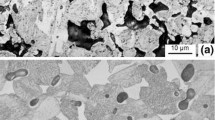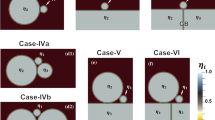Abstract
Particles flow and pack under stress, allowing shaping of the particles into target engineering geometries. Subsequently, in a process termed sintering, the particles are heated to induce bonding that results in a strong solid. Although first practiced 26,000 years ago, sintering was largely unexplained until recent times. Sintering science moved from an empirical and largely qualitative notion into a quantitative theory over a relatively short time period following World War II. That conceptual transition took place just as commercial applications for sintered materials underwent significant growth. This article highlights the key changes in sintering concepts that occurred in the 1945–1955 time period. This time span starts with the first quantitative neck growth model from Frenkel and ends with the quantitative shrinkage model from Kingery and Berg that includes several transport mechanisms.
Similar content being viewed by others
References
R.N. Rhines, Trans. Metall. Soc. AIME 175, 335 (1948).
R.M. German, Sintering: From Empirical Observations to Scientific Principles (Amsterdam: Elsevier, 2014).
W.D. Kingery, in Sintering ‘91, ed. A.C.D. Chaklader and J.A. Lund (Brookfield, VT: Trans Tech, 1992), p. 1.
W.H. Wollaston, Philos. Trans. R. Soc. Lond. 119, 1 (1829).
W.D. Coolidge, Trans. Am. Inst. Elect. Eng. 29, 961 (1910).
K. Schroeter and W. Jenssen, US Patent 1551333, 1925.
T. MacFarlane, US Patent 45597, 1865.
J. Gayley, T. Metall. Soc. AIME 42, 180 (1912).
F.A. Vogel, Sci. Am. 73, 203 (1912).
C. Schnabel, Handbook of Metallurgy (New York, NY: MacMillan, 1898).
W.D. Coolidge, US Patent 1082933, 1913.
C.G. Goetzel, Treatise on Powder Metallurgy, vol. 1 (New York, NY: Interscience, 1949), pp. 259–312.
A.J. Shaler, Trans. Metall. Soc. AIME 185, 796 (1949).
V.V. Skorokhod, Powder Metall. Met. Cer. 53, 529 (2015).
P.E. Wretblad and J. Wulff, in Powder Metallurgy, ed. J. Wulff (Cleveland, OH: American Society for Metals, 1942), p. 36.
G.F. Huttig, Kolloid Z. 98, 6 (1942).
C.G. Goetzel, J. I. Met. 66, 319 (1940).
J. Frenkel, J. Phys. 9, 385 (1945).
B.Y. Pines, Z. Tek. Fiziki 16, 737 (1946).
A.J. Shaler and J. Wulff, Phys. Rev. 72, 79 (1947).
F.V. Lenel, Trans. Metall. Soc. AIME 175, 878 (1948).
G.C. Kuczynski, Trans. Metall. Soc. AIME 185, 169 (1949).
P. Duwez and H. Martens, Trans. Metall. Soc. AIME 185, 572 (1949).
J.K. Mackenzie and R. Shuttleworth, Proc. Phys. Soc. 62, 833 (1949).
C. Herring, J. Appl. Phys. 21, 301 (1950).
A.P. Greenough, Nature 166, 904 (1950).
F.N. Rhines and H.S. Cannon, Trans. Metall. Soc. AIME 191, 529 (1951).
C. Herring, in The Physics of Powder Metallurgy, ed. W.E. Kingston (New York, NY: McGraw-Hill, 1951), p. 143.
H.S. Cannon and F.V. Lenel, in Plansee Proceedings, ed. F. Benesovsky (Reutte, Austria: Metallwerk Plansee, 1953), p. 106.
E.B. Allison and P. Murray, Acta Metall. 2, 487 (1954).
W.D. Kingery and M. Berg, J. Appl. Phys. 26, 1205 (1955).
B.H. Alexander and R. Balluffi, J. Met. 2, 1219 (1950).
G.C. Kuczynski and B.H. Alexander, J. Appl. Phys. 22, 344 (1951).
W.J. Smothers and H.J. Reynolds, J. Am. Ceram. Soc. 37, 588 (1954).
H.H. Hausner, in Symposium on Powder Metallurgy, Special Report 58 (London, UK: Iron and Steel Institute, 1956), p. 102.
B.H. Alexander and R.W. Balluffi, Acta Metall. 5, 666 (1957).
R.L. Coble, J. Am. Ceram. Soc. 41, 55 (1958).
J. Gurland and J.T. Norton, Trans. Metall. Soc. AIME 194, 1051 (1952).
W.D. Kingery, J. Appl. Phys. 30, 301 (1959).
R.M. German, Sintering Theory and Practice (New York, NY: Wiley, 1996).
F.A. Nichols and W.W. Mullins, J. Appl. Phys. 36, 1826 (1965).
S.H. Chung, Y.S. Kwon, S.J. Park, and R.M. German, in Metal Process Simulation, vol. 22B ASM Handbook, ed. D.U. Furrer and S.L. Semiatin (Materials Park, OH: ASM International, 2010), p. 323.
Acknowledgements
The author’s sintering research is funded by NASA (Grant NNX16AK21G), monitored by Dr. Biliyar Bhat of the Marshall Space Flight Center.
Author information
Authors and Affiliations
Corresponding author
Rights and permissions
About this article
Cite this article
German, R.M. The Emergence of Quantitative Sintering Theory from 1945 to 1955. JOM 69, 630–634 (2017). https://doi.org/10.1007/s11837-016-2242-1
Received:
Accepted:
Published:
Issue Date:
DOI: https://doi.org/10.1007/s11837-016-2242-1




